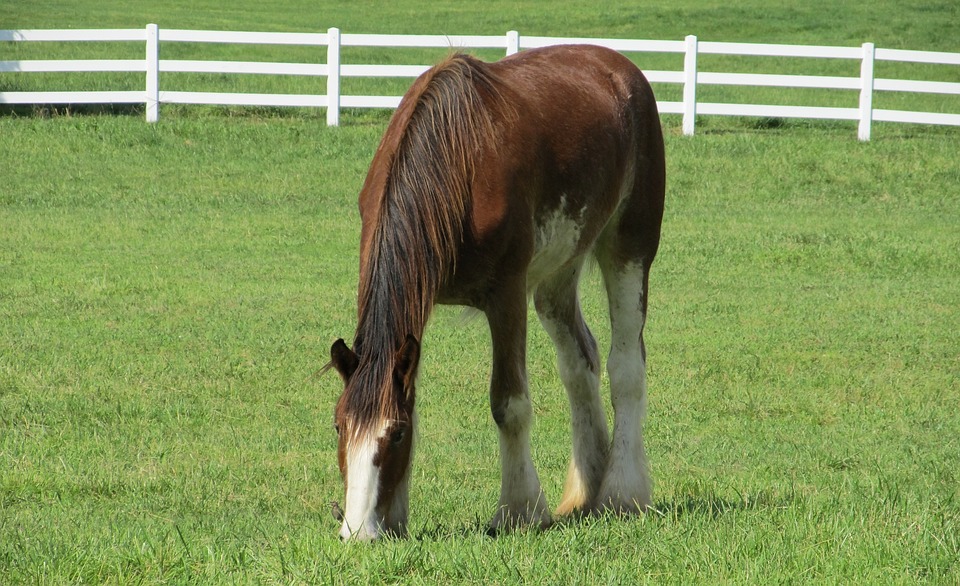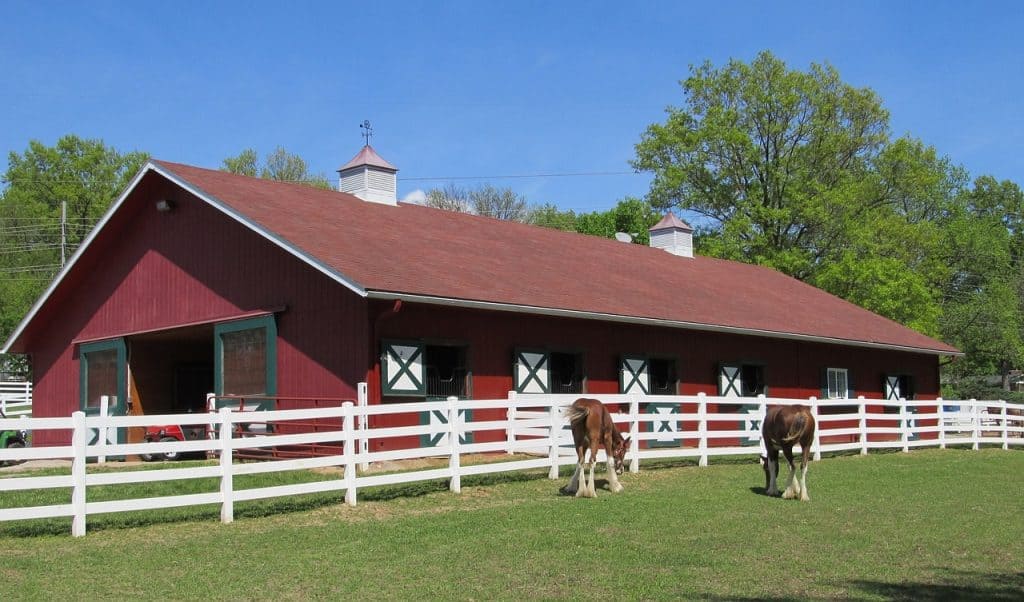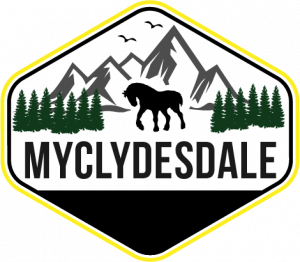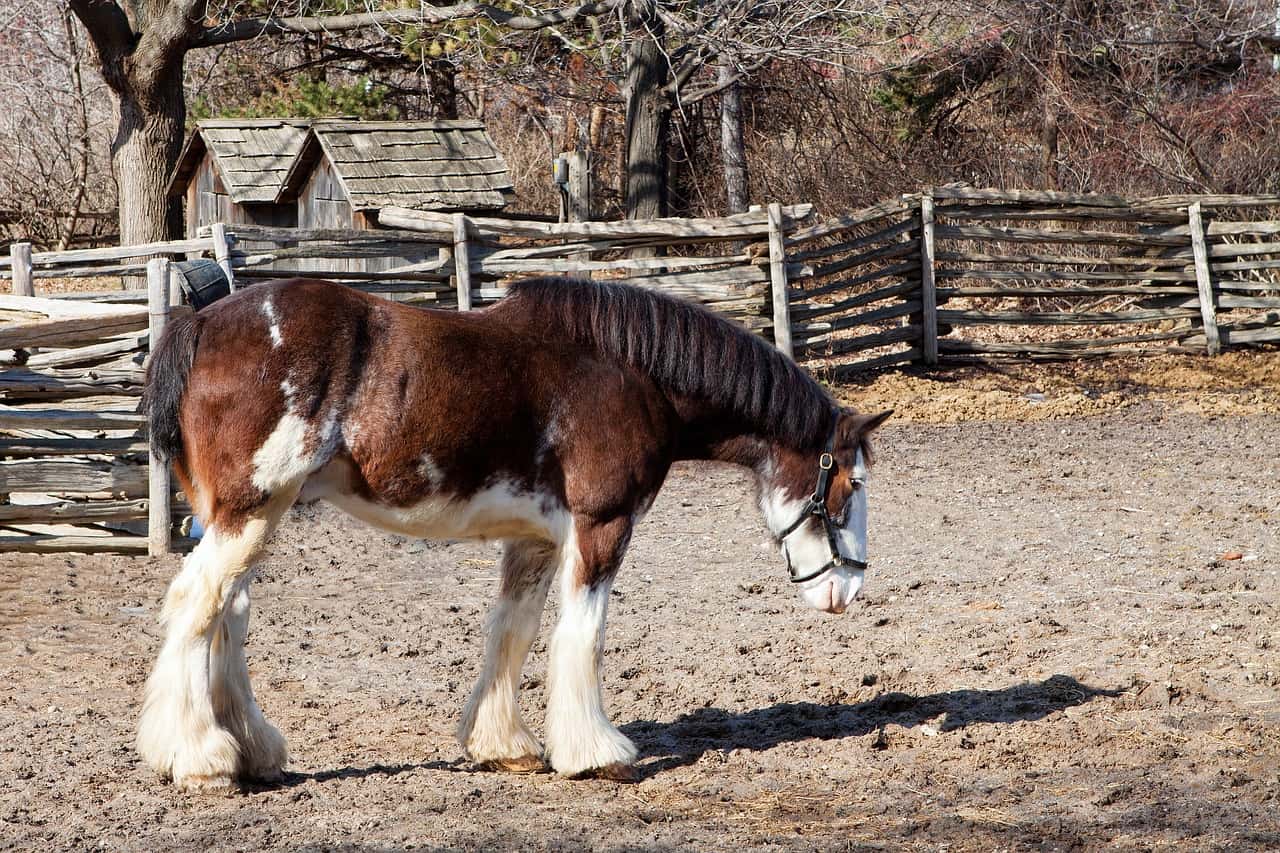The Clydesdale horse is the most prominent breeds worldwide for its beauty, gentleness, and serene nature. They were the first large, durable, and high draft horses to emerge from draft horses in the area of Clydesdale, Scotland. They were thought to be very endangered, but with all the efforts made to save this magnificent breed, the Clydesdale horses are no longer endangered. They can be seen in the United States, Canada, Great Britain, and Australia.
This horse is very easy to spot due to its considerable height and feathers around it. Here, you’re going to explore fascinating facts and things about the Clydesdale horse which you may or may now know. Continue reading!
1. Clydesdale Horse Has Strongest Genetics For Feathering
The “feathering” is the hair around the horse’s hooves and ankles. In the history of this horse breed, it had always this hair. It is considered that this attribute was evolved or developed naturally for the horse to cope with the extreme winter temperatures in Scotland. Other species like Shires utilize the strength of feathering genetics, just to improve feathering in their own horse breed standards.
The Clydesdale horse is becoming more and more popular as a recreational horse, playing an ever-evolving role in sports. One acre owners, business owners, and light horse enthusiasts are well aware of the challenges posed by Clydesdale’s breeding, foam development, and training.
2. Clydesdale Horse Was Once Famous Warhorse
When engaged in battle using Calvary and horses to advantage, this horse was most famous for its size and weight. It has an unusually calm nature, which means it can go into various situations without a spooky. Despite its large size, it is still a friendly, hardy, and gentle horse.
3. Clydesdale Horse Is Considered to Be Endangered
In 1975, the official number in the world was only 80 for Clydesdales. Today 5,000+ have been registered for this horse breed. A variety of programs have assisted to boost awareness about this horse breed to aid save it along with many well-known marketing programs. Anheuser Busch company has long used this horse breed as a component of their branding image and the company maintains a consistent specifically for this horse breed.
The Clydesdale Horse Society was found in 1877 as a breeding registry. These days, breeders and shareholders are working to ensure Clydesdale’s survival. The U.S. has the highest number of Clydesdales, with over 600 additional horses registered each year. The United Kingdom, Canada, and Australia are also on the list after the U.S.
was found in 1877 as a breeding registry. These days, breeders and shareholders are working to ensure Clydesdale’s survival. The U.S. has the highest number of Clydesdales, with over 600 additional horses registered each year. The United Kingdom, Canada, and Australia are also on the list after the U.S.
4. Today, Owning A Clydesdale Horse Is Very Easy.
A big thanks to online resources, anyone who wants to own Clydesdale horse can do so. Listings are available on a constant basis, and most horses in this breed cost $ 10,000 or even less. Sometimes you may find yourself selling for as little as $ 1,000. That initial cost may seem daunting, but it is also important to remember that the average Clydesdale uses twice as much feed per day compared to other horse breeds. It is not uncommon for an adult Clydesdale to consume 60 pounds of grass and 25 quarts of grain per day.

5. Clydesdale Horses As A Breed Are Susceptible To Scratches And Rain Rot
It is due to the thickness of the hair and the quality of the feathers. If a Clydesdale is kept in a humid and muddy environment and does not allow the feet to dry appropriately, moderate to severe scratches can form from time to time. Rain rot is also more common in this horse breed.
6. Clydesdale Horse Breed Feature an Unusual Breed Standard
One of the traits of the Clydesdale horse breed is that it is considered unwelcome in most other species. Often referred to as the “cow hawk,” it leads to the tarsal joint of the hindmost leg to be positioned inward. It creates an appearance of squatting on the leg, making the horse feel like it is “knock-kneed”. Furthermore, this feature helps to create a unique high-stepping gate associated with the horse, enabling them to be streamlined to such an extent so that they can put one back hoof in other’s front as if they were walking on a stability beam.
7. Clydesdale Horse has An Incredible Pulling Power
A single Clydesdale can pull up to 8,000 pounds of weight for a short duration. They can even pull a cart weighing 200-400 pounds for up to 8 hours a day. The 7.5-tonne Clydesdale pull at 15 feet is not part of the record, but their overall tensile strength is one of the toughest ever measured. It is one of the most amazing Clydesdale facts to know.
8. Clydesdale Horse Demands A Double Stall For Comfort.

For most horses, the average stall size tends to be 12 feet by 12 feet. For Clydesdale, the average stall should be at least twice this size or 24 feet by 24 feet. If the Clydesdale horse breed cannot be turned or converted out into a pasture or paddock on a daily basis, then the stall should be even bigger.
9. Clydesdale Horse has Many Uses & Growing Popularity
Although the most popular draft horse is Belgians in the United States, Clydesdale is more popular in America than anywhere else (perhaps because of their Budweiser reputation). Approximately 600 new Clydesdale horses registered in the United States each year, and their number is increasing every year. Simultaneously, the number of horses registered in the United Kingdom is about 800, although it is increasing every year.
Clydesdale was developed for hard work and longtime work. In their ancient history, they were used as battle horses carrying armed soldiers. They threw farm implements, threw forest logs, hauled cargo and milk carts, and did other simple things.
Today, they are used for riding and are regularly crossed with dots to develop strong, level-headed sporty horses. They are still used in agricultural work and logging, but they have been replaced primarily by machinery. They appear regularly at festivals and exhibitions.
10. Clydesdale Horse Has Enormous Feet
Although all draft horses are large, Clydesdale is known for its massive feet, which are “as big as dinner plates.” The adult cavalry usually weighs 5 pounds, which is four times more than a race horseshoe. It is four times more than the cavalry used for Thoroughbred. Unique nails are needed to attach the shoe to the hose, which wraps around the hose wall.
The clear definition of Clydesdale is its massive legs, which is best among Clydesdale facts. They are usually with the size of a frying pan and weigh 5 pounds. In contrast, the average thoroughbred racing horse is about a quarter of that size. In addition to the tube, Clydesdales is also famous for its four white legs with many white feathers. They have steep steps and give an impressive and exceptional performance.
11. Clydesdale Horses Are a Versatile Show Horse
You will find that Clydesdale works well in hitch classes, cart classes, and halter classes. They are excellent therapy horses due to their calm and likable nature. You will find them for trial rides, experiential programming as well as children’s programs. They excel at show jumping and dressage.
due to their calm and likable nature. You will find them for trial rides, experiential programming as well as children’s programs. They excel at show jumping and dressage.
Many have seen Budweiser Clydesdale in advertisements. These horses have been part of the Anheuser Busch since the 1930s. Following the ban, the company used a horse beer cart to market their products. Wagon toured several states and led the way for Budweiser cases. Today, many teams still tour throughout North America and participate in many public events.
12. Newborns Foals for this Horse Breed are Pretty Heavy

The newborn Clydesdale foal can weigh up to 180 pounds and can still be considered the “average” foal. In order to support such big offspring, a broodmare produces 100 pounds of milk per day. They can gain up to 4 pounds each day by increasing the foam on lactating days. Clydesdale is one of the most magnificent horses in the world. The giant Clydesdale horse in Ontario, Canada, is one of the largest horses in the world, standing 20.2 feet high with weight 3,000 pounds.
13. Clydesdale Horses Have Some Exceptional Characteristics
The famous horse’s characteristics are a combination of weight, size, and performance. The first and last form of the Clydesdale lover is the extraordinary wearability of the legs and arms. Any suspicion of contraction can lead to sidebones or ringbone, so the legs should be rounded and the hose wide and springy. To some extent, these further horse requirements are slightly different from conservatism, and they should be noted. The horse should be functional, but not exaggerated and visible to anyone running behind it inside each shoe.
- They are the perfect looking horse.
- They have good character.
- Drowsiness in behavior.
- An intelligent and loyal animal.
- The animal is a different and better-performing draught horse, so you definetly consider the Clydesdale when choosing a horse.
14. Clydesdale Horses Are Big Eaters
Each Clydesdale consumes approximately 20 quarts (19 l) of supplies, 40 to 50 lb. (18 – 23 kg) of grass and 30 gallons (114 l) of water per day. Every Clydesdale on a hitch team is supplied grain two times a day and grass four to seven times a day. They are given water every two hours.
Adult Clydesdale eats 25-50 pounds of grass and 2-10 pounds of grain each day. Depending on the breed, horses have 40 to 48 teeth, which grow continuously throughout life. The cheeks have high crowns to brush the teeth. This powder breaks down the plant cell walls to release digestible contents. The posterior teeth have table-like surfaces that extend over the wedges and grind up and down between the jawbones. The jaw bone moves in a horizontal motion instead of the up and down motion of other mammals, such as humans.
15. Clydesdale Horses Originate From Scotland
Clydesdales are a large draft horse breed founded in the district of Scotland. It was developed by farmers in Lanarkshire, where the Clyde River flows. Lanarkshire’s former name was Clydesdale.
flows. Lanarkshire’s former name was Clydesdale.
Not only to meet the agricultural needs of these farmers but also to meet the commercial needs of the coalfields in Lanarkshire and all sorts of heavy dumping on Glasgow’s streets. The breed soon gained a local reputation and spread over Scotland and northern England over time.
The district system of recruiting stallions was an early feature of the Sathish agricultural sector, and much has been done to standardize and address this breed type. The records of these recruiting societies are, in some cases, 1837. The Clydesdale Horse Society, founded in 1877, has been active in promoting the breed in Great Britain and around the world. Clydesdale, the only British variant of the massive draft, enjoys export trade to various parts of the world. The most active trade is with the Commonwealth countries and the United States.
Today Clydesdale is the only draft race in its native Scotland and New Zealand. It has a commanding lead in Australia and is well known in Canada and the United States, though not a numerical leader.

Last Few Words
These Clydesdale facts demonstrate that this heavy horse is quite popular in several different ways than you could ever imagine. Not only is this horse breed beautiful, but it is even a powerful, strong, yet still pretty gentle. Even though the ownership of this horse breed has a high cost, the initial acquisition expenses for a Clydesdale horse, even with its relative rarity, is pretty low.
More Great Posts To Read.
History of the Clydesdale Horse
Recent Posts
Mastering English Dressage: Tips and Techniques Complete Guide 101
Introduction English dressage is an equestrian sport that involves precise movements and commands between a dressage horse and its rider. It is a graceful, beautiful art form that requires skill...
Introduction Are you looking to learn more about western dressage, the art of horse dressage? If so, you've come to the right place. In the previous blog we looked at Western vs English Dressage,...

